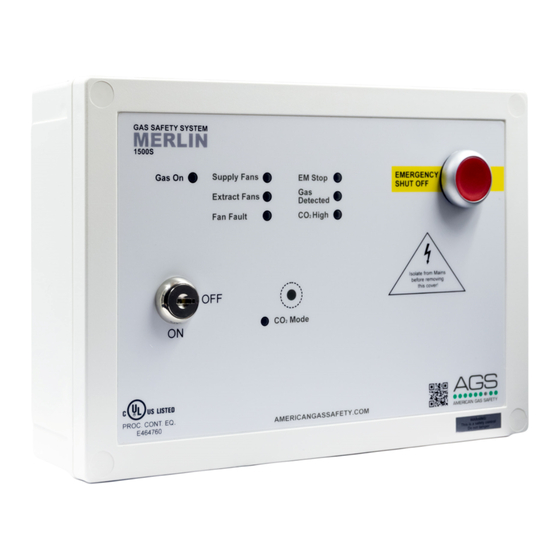AGS Merlin Installation & Operation Instructions - Page 4
Browse online or download pdf Installation & Operation Instructions for Gas Detectors AGS Merlin. AGS Merlin 16 pages. Refrigerant gas detector tft
Also for AGS Merlin: User & Installation Manual (5 pages), User & Installation Manual (6 pages), Installation & Operation Manual (12 pages)

Installation
Introduction
Failure to observe the following may cause injury to persons and/or property.
General
Installation must be carried out by a licenced and insured contractor and installed in areas at risk of gas leaks
e.g., near boilers, valves, or meters, located in positions determined by those who have knowledge of gas
dispersion, the process plant system and equipment involved, and in consultation with both safety and
electrical engineering personnel.
Final positioning of gas detectors should be indicated by the characteristics of the gas being detected and
other environmental factors. Seek advice where necessary. Take in to account the design of the air flow
patterns within the area, sensors should be installed in the correct orientation as per the manufacturer's
specification, and ease of access should be accounted for to allow for any forms of maintenance throughout
its operational life. For installations in North America, the National Electrical Code (NEC) should be strictly
observed, and all appropriate local and national regulations should be observed.
Coverage
There are no official figures of area coverage for a gas detector; however, 50 feet (15.2 metres) per detector
or 7,580 square feet (704.2 square metres) per detector is a reasonable general guide therefore multiple
detectors may be required to adequately protect property and persons.
Positioning
There are no specific standards governing gas detector locations (unlike fire detection systems); there are,
however, general guidance documents. The most relevant being IEC 60079-29-2: Explosive Atmospheres –
Part 29: Gas detectors – Selection, installation, use and maintenance of detectors for flammable gases and
oxygen. Much of what it covers is also relevant to toxic gas & oxygen monitoring equipment.
Recommended heights may vary based on air flow and temperature conditions in addition to the proposed
application, location, and target gas. Sensors should be located near identified sources of a potential gas
leaks/pockets where gas/air could quickly accumulate and areas of identified consequential risk.
The composition of the target gas and its density relative to air are used as the basis for the recommended
height of sensors. Generally, the installation height of a sensor for a heavy gas (e.g., propane/LPG) would be
close to the lowest point in the area, and for a light gas (such as methane) would be close to the highest
point in the area. These typical positions may vary based on air flow and temperature conditions in addition to
the proposed application and location – this is particularly apparent with oxygen depletion sensors, and the
target gas that they are used for.
Target Gas
Refrigerant: R134a / 410a / 32
Rev 01
Merlin Gas Detector Installation & Operation Instructions
Typical Install Height
As close to the ground level.
Page 4 of 16
